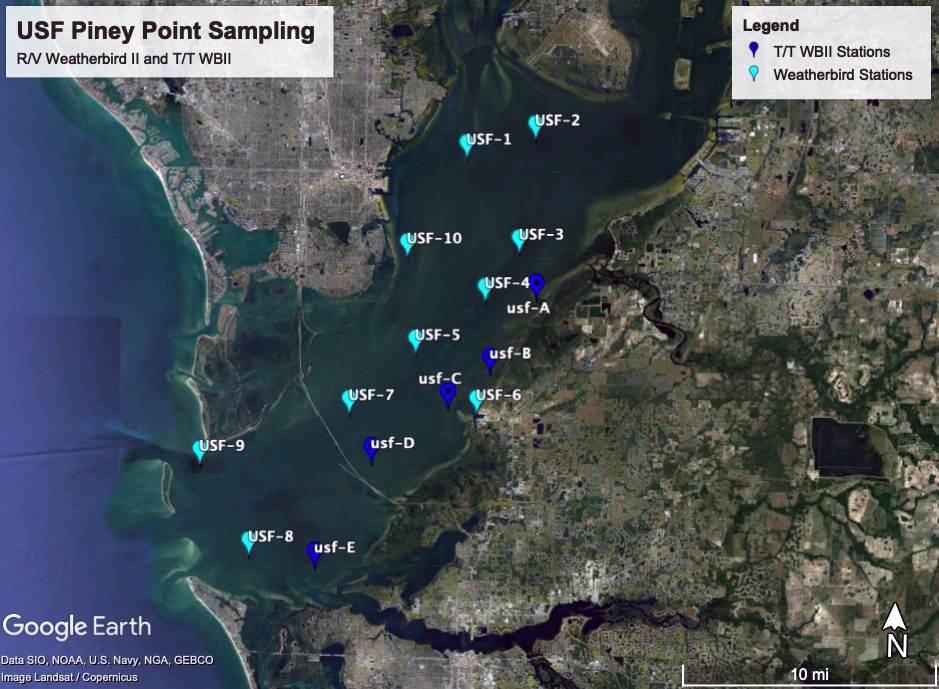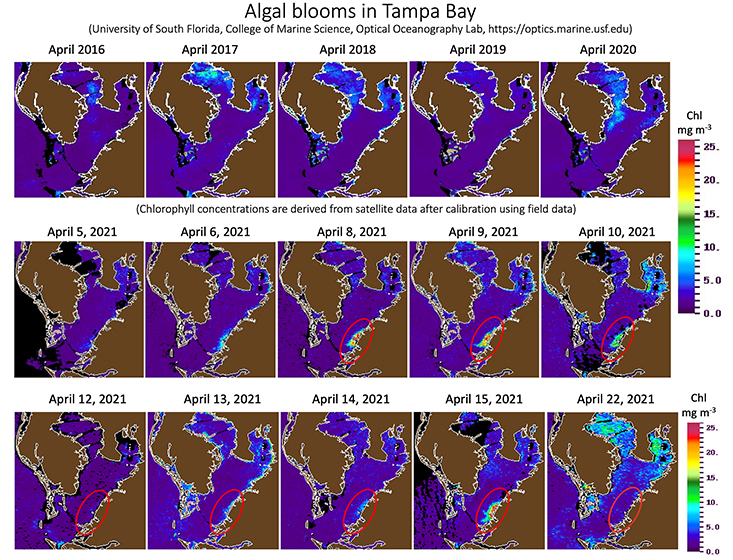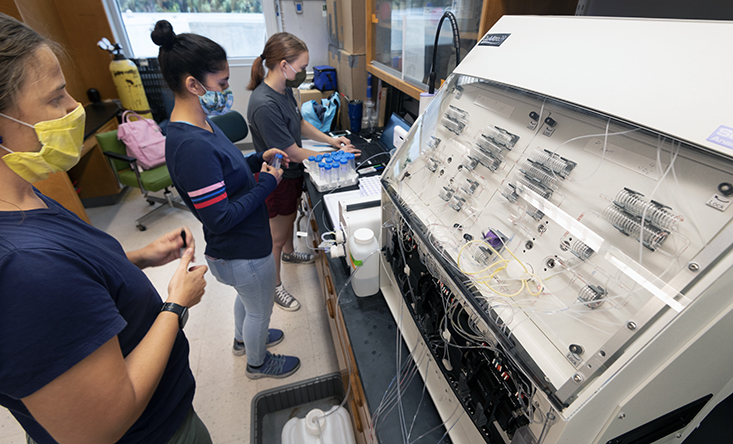Media Contact:
Carrie O’Brion
727-698-2611 (cell)
carrieobrion@usf.edu
A recording of today’s media opportunity, along with b-roll and photos of researchers and other assets for media use are available here.
ST. PETERSBURG, Fla. (May 24, 2021) – University of South Florida College of Marine Science researchers today shared their initial findings of how the Tampa Bay ecosystem has responded to the controlled discharges of nutrient-rich wastewater released from the retired Piney Point fertilizer processing plant. The scientists launched their first research cruise on April 7 and have returned to the water several times since.
Key takeaways from the USF research team
- Early results indicate that the effects of the wastewater discharge were localized in nature, not widespread.
- Concentrations of nutrients have declined over time and are now more typical of those in the historical record for this part of Tampa Bay. Model results show that the concentrations of nutrients within the discharged water have been diluted at least 1000-fold since the initial release.
- A diatom bloom of about 25 square kilometers in size around Port Manatee that formed in response to the discharge has dissipated over time. Diatoms are single-celled microalgae called phytoplankton. Chlorophyll concentrations (a proxy for phytoplankton biomass) are within the range generally observed in Tampa Bay during April and May.
Remaining unanswered questions for researchers
- Are longer-term impacts of the discharged water on the Tampa Bay ecosystem likely to be manifested? If so, how?
- The nutrient chemistry of Tampa Bay is complex. Questions remain about nutrient cycling
in response to a rapid influx of wastewater. For example:
- Were nutrients and heavy metals (e.g., lead, copper, zinc) from the discharge sequestered in the sediments? If so, will storms stimulate phytoplankton blooms?
- Will there be an impact to seagrasses and other marine life that live on the bottom?
- What may have been the impact to fish health?
Additional information and quotes from USF scientists
“The area in the immediate vicinity of Port Manatee was subject to a spike in nutrient concentrations and a corresponding increase in phytoplankton abundance,” College of Marine Science Dean Tom Frazer said. “Our initial field sampling efforts and data acquired from remote sensing platforms confirmed high concentrations of chlorophyll, which is a proxy for phytoplankton abundance. Recent data indicate, however, that the response was short lived. Phytoplankton abundance continues to decline and water chemistry values are typical of those reported in the historical record.”

The field team, led by USF chemical oceanographer Kristen Buck collected water and sediment samples from a suite of stations in the vicinity of Port Manatee and locations beyond the affected area. The sampling and subsequent data analyses confirmed that the phytoplankton responded quickly to the nutrient pulse, but the assemblage was dominated by diatoms and not toxic phytoplankton responsible for red tides. The algal bloom has since dissipated. The end of the algae bloom was confirmed in satellite imagery analyzed by physical oceanographer Chuanmin Hu (see “Hu satellite imagery” here).
The team’s sampling efforts were guided by a model provided by physical oceanographer Bob Weisberg. The model forecasts the movement of discharged water and its constituents based on tides, winds and river input. A summary of this model and its results are included here (see Word doc here, “Piney Point Effluent Concentration Modeling”).
“Although the residency time of water in Tampa Bay is on the order of months and the bay flushes slowly, the discharged water seems to have been diluted pretty quickly,” Weisberg said.
Many questions remain and any longer-term impacts on the ecosystem remain unknown. For example, biological oceanographer Steve Murawski collected fish to understand any impacts to fish health, but those samples will take longer to process.
“We will continue to work with state agencies leading the response effort and other local partners to sample water and sediments potentially affected by the discharge to better understand the transport, transformation, and fate of its chemical constituents, nitrogen and phosphorus in particular,” Buck said.
The USF research team collected water samples, surface sediments and fish from Tampa Bay and Port Manatee. In total they led five research cruises in April in partnership with the Florida Institute of Oceanography (FIO) aboard the R/V Weatherbird II, performed additional shore-based sampling on April 12-13 and partnered with the Florida Fish & Wildlife Commission (FWC) for small-boat sampling efforts on April 21 and April 29. Additional research cruises are tentatively scheduled for the end of May and late June.
The full suite of the data being collected at Piney Point, including USF’s data, can be viewed on a dashboard maintained by the Tampa Bay Estuary Program.
Use of the ship in the early days was made possible by FIO. USF is working with partners at Florida Fish & Wildlife Conservation Commission, Eckerd College, Florida State University, Woods Hole Oceanographic Institution, and more.

Top row: Satellite imagery showing that an algal bloom in the location of the Piney Point event in April in Tampa Bay is rare. Bottom two rows: Satellite images dated from April 5-22 showing bloom formation and dissipation (end) as of April 22, 2021. Credit: USF College of Marine Science, Optical Oceanography Lab.
About the University of South Florida
The University of South Florida is a high-impact global research university dedicated to student success. Over the past 10 years, no other public university in the country has risen faster in U.S. News and World Report’s national university rankings than USF. Serving more than 50,000 students on campuses in Tampa, St. Petersburg and Sarasota-Manatee, USF is designated as a Preeminent State Research University by the Florida Board of Governors, placing it in the most elite category among the state’s 12 public universities. USF has earned widespread national recognition for its success graduating under-represented minority and limited-income students at rates equal to or higher than white and higher income students. USF is a member of the American Athletic Conference. Learn more at www.usf.edu.
